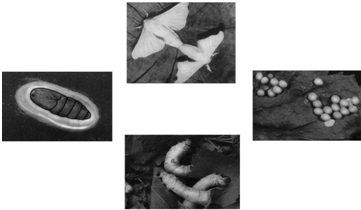养蚕织丝在我国有着悠久的历史.如图表示桑蚕的不同发育时期,请回答下列问题:
(1)从图中看出,蚕的发育经历______时期,这种发育过程从幼体到成体有较大的变化,称为______.
(2)蚕的体细胞中有28对染色体,它产生的精子或卵细胞中染色体的数目是______.
(3)课外养蚕小组的同学发现,黄足蚕结黄茧,白足蚕结白茧.他们选用黄足蚕与白足蚕杂交,后代全是黄足蚕,说明黄足是______性状;如果控制相对性状的基因用A、a表示,则亲代蚕和子代蚕的基因组成分别是______;若让子代蚕与白足蚕杂交,推测后代黄足蚕和白足蚕的比例是______.
(4)2008年,我国的桑蚕育种专家将水母的绿色荧光蛋白基因转移到桑蚕的体内,培育出能吐绿色荧光蚕丝的新品种.这项现代生物技术称为______,这个事例说明基因与性状的关系是______.
(5)蚕与人类的关系非常密切,请你列举两个事例:______.

(1)家蚕的生殖发育经过受精卵、幼虫、蛹和成虫等4个时期的叫完全变态发育.完全变态发育的幼虫与成虫在形态构造和生活习性上明显不同,差异很大.
(2)体细胞形成生殖细胞时,染色体的数目要减少一半
(3)黄足蚕与白足蚕杂交,后代全是黄足蚕,说明黄足是显性性状;如果控制相对性状的基因用A、a表示,则亲代蚕和子代蚕的基因组成分别是;AA和aa、Aa若让子代蚕与白足蚕杂交,推测后代黄足蚕和白足蚕的比例是1:1
(4)2008年,我国的桑蚕育种专家将水母的绿色荧光蛋白基因转移到桑蚕的体内,培育出能吐绿色荧光蚕丝的新品种.这项现代生物技术称为转基因技术,这个事例说明基因与性状的关系是基因控制生物的性状.
(5)蚕与人类的关系非常密切:蚕丝为人类提供丝织品;蚕蛹可供食用;蚕是中外文化交流--丝绸之路的重要基础;蚕赋予诗人灵感,形成脍炙人口的诗篇等等
故答案为:
(1)卵、幼虫、蛹和成虫;完全变态
(2)28条
(3)显性 AA和aa、Aa 1:1
(4)转基因技术 基因控制生物的性状
(5)蚕丝为人类提供丝织品;蚕蛹可供食用;蚕是中外文化交流--丝绸之路的重要基础;蚕赋予诗人灵感,形成脍炙人口的诗篇等等(开放性试题,答案中体现政治、经济、文化、生活、艺术等方面合理内容即可得分)
